joint support
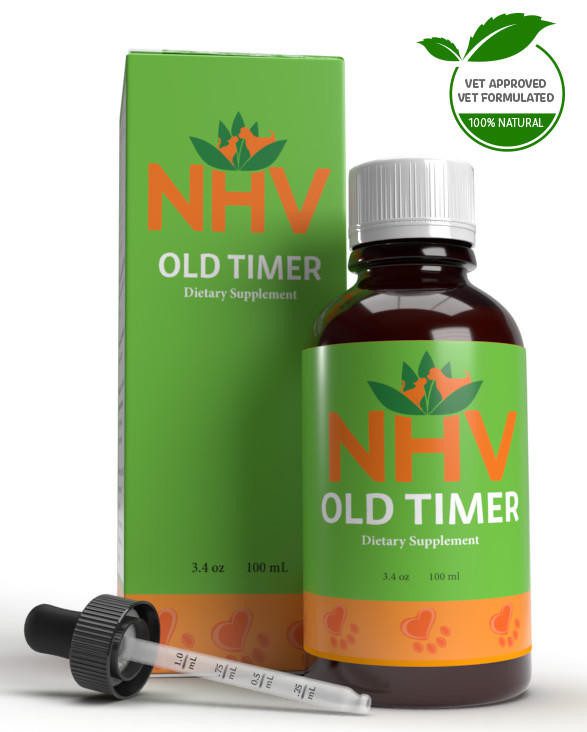
free shipping over $100 (USA & Canada)
1-877-937-4372 the pet expert hotline
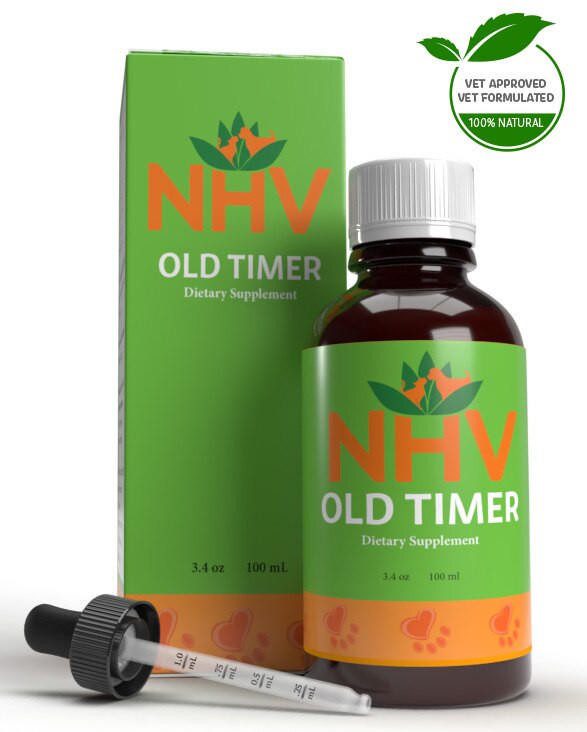
Natural dog joint support to alleviate arthritis, muscle, and joint discomfort

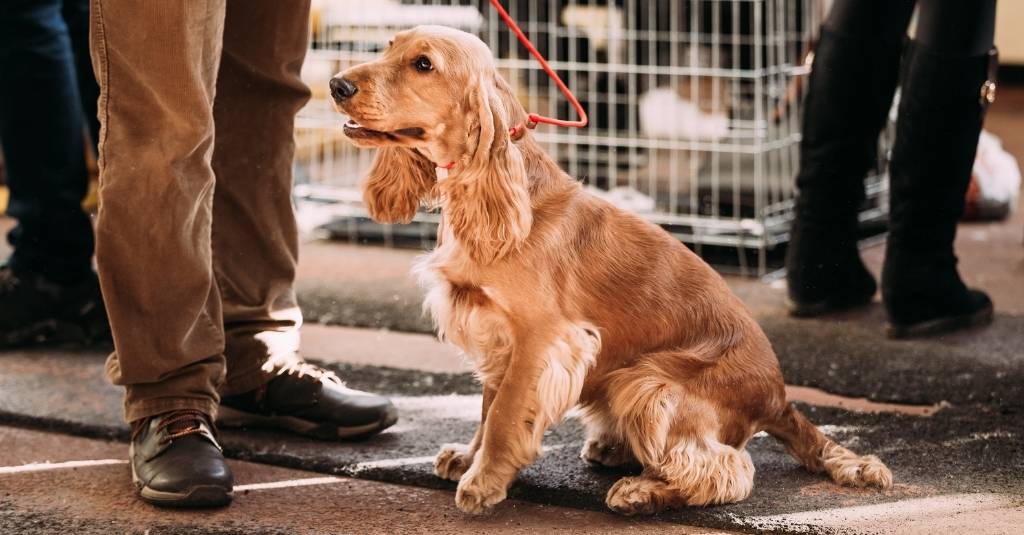
Just like humans, dogs have two ligaments that help to stabilize the stifle (knee) joint. In pets, these ligaments are called the cranial cruciate ligament and the caudal cruciate ligament. The word ‘cruciate’ means ‘to cross’. These ligaments cross over one another between the bones that form the stifle joint to stabilize the joint.
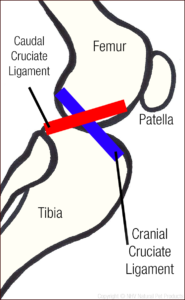
The most common time for this injury to occur is with a burst of speed.
A very common injury in dogs is the cranial crucial ligament tears (equivalent to the anterior cruciate ligament, ‘ACL’, in humans). When this ligament is put under intense strain due to an awkward sudden movement or repetitive motion it can tear or rupture. When this ligament is damaged, it is no longer able to support the stifle joint, causing the joint to slip uncomfortable forward with each step.
The first sign that pet parents often notice with a ruptured cruciate ligament is a sudden cry of discomfort. The most common time for this injury to occur is with a burst of speed, like chasing a ball or running after a squirrel. These activities put a huge amount of stress on the knee and often involve a quick directional change. The pet parent will notice their dog cry out and then be reluctant to put any weight on the affected leg.
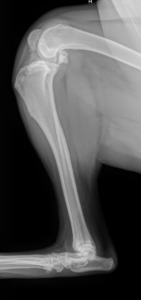
To veterinary staff, who unfortunately see many of these types of injuries, the diagnosis is usually fairly clear from the moment the dog enters the clinic. Because of the degree of discomfort, the dog will often not put any weight on the leg at all but will only be ‘toe touching’, just gently touching the ground, with that foot. Confirming diagnosis involves x-rays and joint manipulation. There is a distinctive movement, called a ‘drawer sign’, that occurs when the veterinarian manipulates the joint. This movement is the joint sliding back to front which is only possible with a rupture of the ligament.
If left untreated, this injury causes severe discomfort and eventually causes severe arthritic changes in the joint. It can also lead to a build-up of fluid, or ‘effusion’ in the joint.
The only effective treatment for a torn cruciate ligament is surgery. Some smaller dogs may be able to manage with long-term discomfort medications; however, this is not ideal. This condition is extremely uncomfortable and damaging to the joint. One of the most common surgical procedures for a torn cruciate ligament is a tibial plateau leveling osteotomy (TPLO). In this procedure, the ligament is not repaired, but the joint is reoriented to prevent uncomfortable slipping. This makes the cranial cruciate ligament unnecessary.
One of the main bones that form the stifle joint is the tibia. The surgeon will measure the angles of this joint on x-ray and will surgically reshape the joint by cutting a notch from the top of the bone and rotating it. This levels out the top, or plateau, of the tibia and prevents the joint from slipping. The cut bone is then reattached using a surgical plate. The benefit to this surgery is that there is no chance of a re-rupture in this joint.

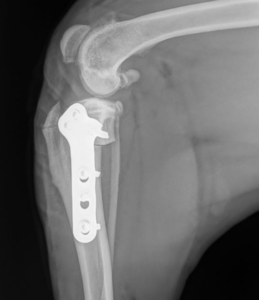
There is no absolute way to prevent cruciate ligament tears. Larger breed dogs are more likely to face this type of injury. One factor for this injury can be obesity. Extra weight on the body puts undue stress on the joints which can weaken the ligaments over time and lead to rupture.
Unfortunately, most dogs who rupture one cruciate ligament end up rupturing the other side at some point. This is either due to a genetic predisposition or to the change in the dog’s gait after surgery. The dog will naturally put more weight and strain on the healthy joint after surgery, increasing the chances of injury to the healthier joint.
NHV Old Timer, Turmeric, and Yucca can be beneficial leading up to and after surgery to help your dog heal comfortably and to help ease the discomfort of any joint changes such as arthritis or effusion. They work together synergistically to help fight inflammation and ease discomfort.
If your pup is suffering from a cruciate tear or another uncomfortable orthopedic condition, contact our pet experts to find out which supplements may help.
joint support

For Arthritis, Muscle and Joint Discomfort Relief in Cats.
buy 2 and save $3
3 month supply for a small to medium size pet
What Is It?
Old Timer is a natural supplement that supports cat joint movement, relieves discomfort, and reduces inflammation.
How Does it Work?
Why Should I Trust It?
Vet-formulated, holistic supplement safe to use long-term.

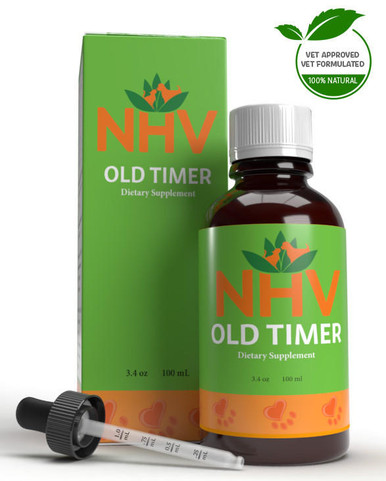
What Is It?
Old Timer is a natural supplement that supports cat joint movement, relieves discomfort, and reduces inflammation.
How Does it Work?
Why Should I Trust It?
Vet-formulated, holistic supplement safe to use long-term.

Provide cat joint support and ease the discomfort arthritis can cause with Old Timer, an herbal tonic that helps in the management of arthritis and its symptoms. Arthritis is a degenerative disease that tends to affect the elbow joints in cats (though any joint can be affected). It’s a debilitating condition that can lead to hip dysplasia and impaired mobility.
Arthritis gradually becomes worse over time and can become debilitating to your cat. To help with this condition, keep your cat away from cold or damp areas and provide opportunities to stimulate them with exercise.
Also, talk to your vet about means of joint discomfort relief for your cat. Adding holistic supplements, such as those by NHV to your vet’s conventional treatment plan, along with other holistic therapies like hydrotherapy and acupuncture is an effective way to provide excellent cat joint support.
Getting or keeping your frosted face kitty or doggo at a healthy weight can help decrease the pressure on the bones and joints.
Vet-formulated, holistic supplements by NHV are safe to use long-term. They’re ethically-sourced with Non-GMO ingredients. If you have questions, ask our pet experts at NHV. We’re here to help alleviate your pet’s discomfort naturally.
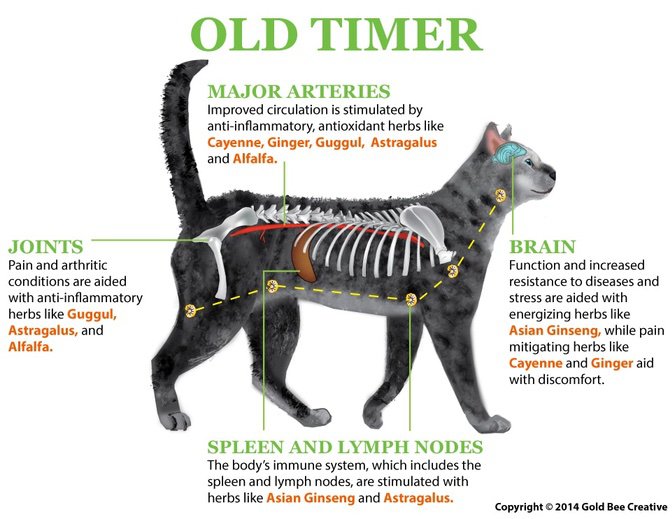
Guggul – Eases uncomfortable arthritis symptoms.
Asian Ginseng – Contains natural immune-supporting properties.
Ginger – An antioxidant and anti-inflammatory.
Astragalus – Helps support the immune system by enhancing phagocytic activity and increasing interferon production.
Alfalfa – A plant containing vitamins, amino acids, minerals, and high protein levels.
Cayenne – A tonic with anti-inflammatory properties.
Select your pet's weight to determine the correct dose.
To be taken twice daily. Determine your pet’s weight and then use the easy chart below to determine the correct dose. This is the minimum dosage.
Pet's Weight Dosage
0 - 15 lb = 0.5 ml
16 - 30 lb = 1.0 ml
31 - 45 lb = 1.5 ml
46 - 60 lb = 2.0 ml
61 - 75 lb = 2.5 ml
Over 75 lb = 3.0 ml
How to Administer
Shake well before use. The easiest method is to use the dropper provide and places the drops into your pet’s food or favorite treat. You can also use the dropper and squirt directly into the pet’s mouth.
Some pets can be finicky, if this occurs consider hiding the drops in foods most pet’s love such as fish, chicken or yogurt or a favorite treat. If your pet only eats dry food then soak a few kibbles at feeding time.
For Best Results
Herbal dietary supplements are beneficial to the health and wellbeing of your pet and are safe for long-term use. Every pet responds to natural herbal supplements differently, therefore it is important to be consistent and administer the product daily. Supplements generally take two to four weeks to take effect, however this will vary from one animal to the next.
Product Storage
All NHV Natural Pet Products are pure herbal extracts and contain no artificial additives, preservatives or coloring. Shelf life after opening is 6 months and must be refrigerated after opening.
Cautions and Contraindications
Do not use Old Timer in pregnant or nursing animals. Should be used in moderation in cases of sensitive digestive tract. Speak to your vet before using our products. A second visit is recommended if your pet’s condition does not improve, or deteriorates after continued use of the supplements.
All information provided by NHV Natural Pet Products is for educational purposes only.
Provide cat joint support and ease the discomfort arthritis can cause with Old Timer, an herbal tonic that helps in the management of arthritis and its symptoms. Arthritis is a degenerative disease that tends to affect the elbow joints in cats (though any joint can be affected). It’s a debilitating condition that can lead to hip dysplasia and impaired mobility.
Arthritis gradually becomes worse over time and can become debilitating to your cat. To help with this condition, keep your cat away from cold or damp areas and provide opportunities to stimulate them with exercise.
Also, talk to your vet about means of joint discomfort relief for your cat. Adding holistic supplements, such as those by NHV to your vet’s conventional treatment plan, along with other holistic therapies like hydrotherapy and acupuncture is an effective way to provide excellent cat joint support.
Getting or keeping your frosted face kitty or doggo at a healthy weight can help decrease the pressure on the bones and joints.
Vet-formulated, holistic supplements by NHV are safe to use long-term. They’re ethically-sourced with Non-GMO ingredients. If you have questions, ask our pet experts at NHV. We’re here to help alleviate your pet’s discomfort naturally.

Guggul – Eases uncomfortable arthritis symptoms.
Asian Ginseng – Contains natural immune-supporting properties.
Ginger – An antioxidant and anti-inflammatory.
Astragalus – Helps support the immune system by enhancing phagocytic activity and increasing interferon production.
Alfalfa – A plant containing vitamins, amino acids, minerals, and high protein levels.
Cayenne – A tonic with anti-inflammatory properties.
Select your pet's weight to determine the correct dose.
To be taken twice daily. Determine your pet’s weight and then use the easy chart below to determine the correct dose. This is the minimum dosage.
Pet's Weight Dosage
0 - 15 lb = 0.5 ml
16 - 30 lb = 1.0 ml
31 - 45 lb = 1.5 ml
46 - 60 lb = 2.0 ml
61 - 75 lb = 2.5 ml
Over 75 lb = 3.0 ml
How to Administer
Shake well before use. The easiest method is to use the dropper provide and places the drops into your pet’s food or favorite treat. You can also use the dropper and squirt directly into the pet’s mouth.
Some pets can be finicky, if this occurs consider hiding the drops in foods most pet’s love such as fish, chicken or yogurt or a favorite treat. If your pet only eats dry food then soak a few kibbles at feeding time.
For Best Results
Herbal dietary supplements are beneficial to the health and wellbeing of your pet and are safe for long-term use. Every pet responds to natural herbal supplements differently, therefore it is important to be consistent and administer the product daily. Supplements generally take two to four weeks to take effect, however this will vary from one animal to the next.
Product Storage
All NHV Natural Pet Products are pure herbal extracts and contain no artificial additives, preservatives or coloring. Shelf life after opening is 6 months and must be refrigerated after opening.
Cautions and Contraindications
Do not use Old Timer in pregnant or nursing animals. Should be used in moderation in cases of sensitive digestive tract. Speak to your vet before using our products. A second visit is recommended if your pet’s condition does not improve, or deteriorates after continued use of the supplements.
All information provided by NHV Natural Pet Products is for educational purposes only.
arthritis support
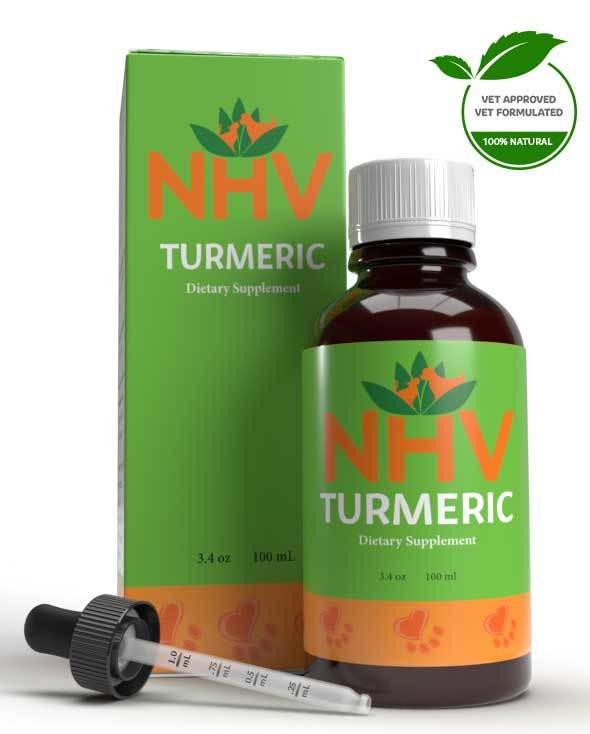
For Arthritis and Cancer Support
buy 2 and save $3
3 month supply for a small to medium size
What is it?
NHV Turmeric for Dogs is a natural, antioxidant-rich supplement that supports dogs with arthritis, cancer, and other conditions that cause inflammation.
How does it work?
Why trust it?
NHV Turmeric uses a full-spectrum extract of human-grade turmeric root.
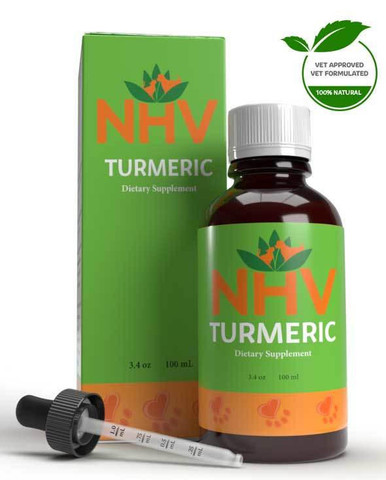
What is it?
NHV Turmeric for Dogs is a natural, antioxidant-rich supplement that supports dogs with arthritis, cancer, and other conditions that cause inflammation.
How does it work?
Why trust it?
NHV Turmeric uses a full-spectrum extract of human-grade turmeric root.
Dogs love to root around in the dirt for goodies. But did you know one of the best things they could find would be turmeric? Sadly, your pup won’t find turmeric in their backyards unless you live in the tropics, where this amazing plant grows. However, they can benefit from this golden plant by taking a full-spectrum extract of Turmeric for Dogs.
Is turmeric good for dogs? Yes, most pups can use this safe and gentle herb for a number of health concerns. This is thanks to the organic compounds produced by the plant.
If you’re the pet parent of a sick pup, you might have a challenging journey ahead. Remember that the love you feel for your dog will also play a big role, and if you need a little advice, our pet experts are here for you and can be reached by chat.
How does this incredible spice work? Turmeric is rich in antioxidants, which can help your precious pet with stress, pollution, and illness.
Pets that are sick have increased oxidation, so the antioxidants they get from food, medication, or supplements can help give them the extra they need.
As pet-parents ourselves, we know you only want the best for your pup. That’s why our extracts are made from human-grade, high quality ingredients. And when you choose NHV Turmeric, you’re choosing decades of holistic pet wellness experience from vets and herbalists who can help support your pet’s wellness journey. Our formula is:
Our turmeric was formulated by a master herbalist and holistic vet. Learn more about Dr. Hillary Cook’s use of turmeric and its benefits for pet health. We are also proud to have been a part of many dog success stories, like with our doggo friend, Captain Morgan.
Captain Morgan’s story: “Our bloodhound has been on turmeric for 2 months now. He has been getting up and down more smoothly and not as stiff in his backend. He loves the taste and we love how it has helped him
You can add daily supplements like Turmeric to top up your dog’s intake of natural, wellness-promoting ingredients. It can be given directly by mouth with the dropper provided, or it can be mixed into food or a favorite treat (this tip is dog-approved)!
All NHV supplements are made with the finest quality organic or ethically harvested herbs. We use non-GMO vegetable glycerin as our base. NHV products are full-spectrum extracts.
Select your pet's weight to determine the correct dose.
To be taken twice daily. Determine your pet’s weight and then use the easy chart below to determine the correct dose. This is the minimum dosage.
Pet's Weight Dosage
0 - 15 lb = 0.5 ml
16 - 30 lb = 1.0 ml
31 - 45 lb = 1.5 ml
46 - 60 lb = 2.0 ml
61 - 75 lb = 2.5 ml
Over 75 lb = 3.0 ml
How to Administer
Shake well before use. The easiest method is to use the dropper provide and places the drops into your pet’s food or favorite treat. You can also use the dropper and squirt directly into the pet’s mouth.
Some pets can be finicky, if this occurs consider hiding the drops in foods most pet’s love such as fish, chicken or yogurt or a favorite treat. If your pet only eats dry food then soak a few kibbles at feeding time.
For Best Results
Herbal dietary supplements are beneficial to the health and wellbeing of your pet and are safe for long-term use. Every pet responds to natural herbal supplements differently, therefore it is important to be consistent and administer the product daily. Supplements generally take two to four weeks to take effect, however this will vary from one animal to the next.
Product Storage
All NHV Natural Pet Products are pure herbal extracts and contain no artificial additives, preservatives or coloring. Shelf life after opening is 6 months and must be refrigerated after opening.
Cautions and Contraindications: Do not use Turmeric in pregnant or nursing animals. Speak to your vet before using our products. A second visit is recommended if your pet’s condition does not improve, or deteriorates after continued use of the supplements.
Dogs love to root around in the dirt for goodies. But did you know one of the best things they could find would be turmeric? Sadly, your pup won’t find turmeric in their backyards unless you live in the tropics, where this amazing plant grows. However, they can benefit from this golden plant by taking a full-spectrum extract of Turmeric for Dogs.
Is turmeric good for dogs? Yes, most pups can use this safe and gentle herb for a number of health concerns. This is thanks to the organic compounds produced by the plant.
If you’re the pet parent of a sick pup, you might have a challenging journey ahead. Remember that the love you feel for your dog will also play a big role, and if you need a little advice, our pet experts are here for you and can be reached by chat.
How does this incredible spice work? Turmeric is rich in antioxidants, which can help your precious pet with stress, pollution, and illness.
Pets that are sick have increased oxidation, so the antioxidants they get from food, medication, or supplements can help give them the extra they need.
As pet-parents ourselves, we know you only want the best for your pup. That’s why our extracts are made from human-grade, high quality ingredients. And when you choose NHV Turmeric, you’re choosing decades of holistic pet wellness experience from vets and herbalists who can help support your pet’s wellness journey. Our formula is:
Our turmeric was formulated by a master herbalist and holistic vet. Learn more about Dr. Hillary Cook’s use of turmeric and its benefits for pet health. We are also proud to have been a part of many dog success stories, like with our doggo friend, Captain Morgan.
Captain Morgan’s story: “Our bloodhound has been on turmeric for 2 months now. He has been getting up and down more smoothly and not as stiff in his backend. He loves the taste and we love how it has helped him
You can add daily supplements like Turmeric to top up your dog’s intake of natural, wellness-promoting ingredients. It can be given directly by mouth with the dropper provided, or it can be mixed into food or a favorite treat (this tip is dog-approved)!
All NHV supplements are made with the finest quality organic or ethically harvested herbs. We use non-GMO vegetable glycerin as our base. NHV products are full-spectrum extracts.
Select your pet's weight to determine the correct dose.
To be taken twice daily. Determine your pet’s weight and then use the easy chart below to determine the correct dose. This is the minimum dosage.
Pet's Weight Dosage
0 - 15 lb = 0.5 ml
16 - 30 lb = 1.0 ml
31 - 45 lb = 1.5 ml
46 - 60 lb = 2.0 ml
61 - 75 lb = 2.5 ml
Over 75 lb = 3.0 ml
How to Administer
Shake well before use. The easiest method is to use the dropper provide and places the drops into your pet’s food or favorite treat. You can also use the dropper and squirt directly into the pet’s mouth.
Some pets can be finicky, if this occurs consider hiding the drops in foods most pet’s love such as fish, chicken or yogurt or a favorite treat. If your pet only eats dry food then soak a few kibbles at feeding time.
For Best Results
Herbal dietary supplements are beneficial to the health and wellbeing of your pet and are safe for long-term use. Every pet responds to natural herbal supplements differently, therefore it is important to be consistent and administer the product daily. Supplements generally take two to four weeks to take effect, however this will vary from one animal to the next.
Product Storage
All NHV Natural Pet Products are pure herbal extracts and contain no artificial additives, preservatives or coloring. Shelf life after opening is 6 months and must be refrigerated after opening.
Cautions and Contraindications: Do not use Turmeric in pregnant or nursing animals. Speak to your vet before using our products. A second visit is recommended if your pet’s condition does not improve, or deteriorates after continued use of the supplements.
discomfort support
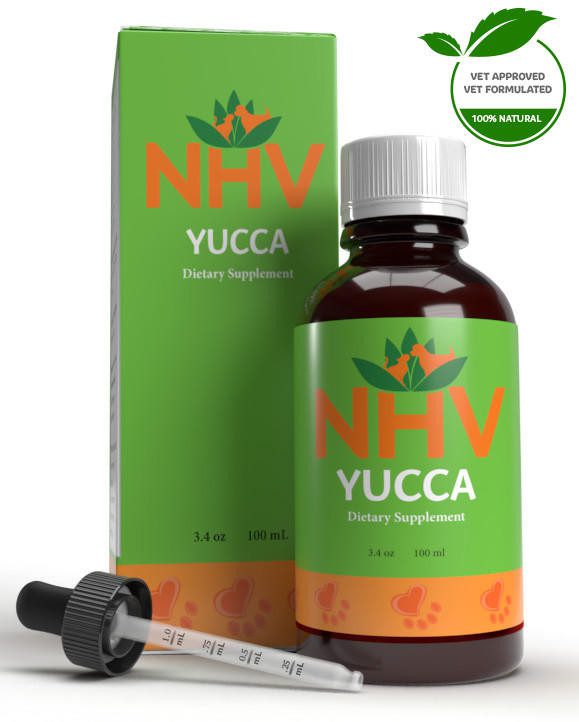
Discomfort Relief, Digestive Support, and Dog Appetite Booster
buy 2 and save $3
3 month supply for a small to medium size
What is it?
Yucca for dogs is an all-natural supplement that can be helpful in many circumstances by providing symptom relief related to inflammation, discomfort, and loss of appetite.
How does it work?
Why trust it?
NHV uses only human-grade herbs processed in a GMP-certified facility, so your pet gets the best natural support.


What is it?
Yucca for dogs is an all-natural supplement that can be helpful in many circumstances by providing symptom relief related to inflammation, discomfort, and loss of appetite.
How does it work?
Why trust it?
NHV uses only human-grade herbs processed in a GMP-certified facility, so your pet gets the best natural support.

Yucca root is widely used in dog food as well as in other pet foods. It is an herb that is highly nutritive as it is rich in vitamin C, beta-carotene, B vitamins, magnesium, iron, calcium, manganese, protein, niacin, and phosphorus. Yucca contains two very beneficial compounds: sarsasapogenin and smilagenin. These two compounds work on the mucous membranes of the small intestine. These compounds help with the penetration and absorption of minerals and vitamins. Sarsasapogenin and Smilagenin are known as steroidal saponins (phytosterols), which act as precursors to corticosteroids produced naturally by the body.
Steroidal-saponins support the immune function of the body while stimulating and supporting the production of its own corticosteroids and corticosteroid–related hormones. Due to this action, studies conducted on yucca have shown that it may be beneficial and effective for discomfort and inflammation in conditions such as arthritis. Yucca may also be effective as an appetite booster in dogs and may also help reduce the production of urease, which contributes to the unpleasant odors of urine and feces in some dogs.
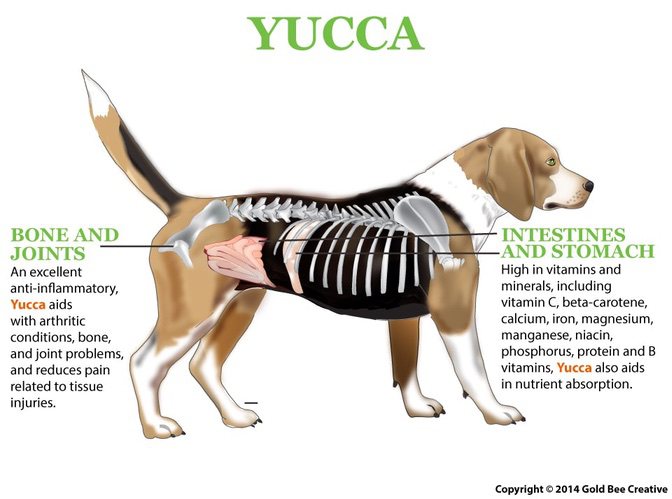
Yucca for dogs is commonly used for supporting arthritis, as an anti-inflammatory, nutritive, antitumor, and digestive. Yucca for dogs is considered a nutritive herb because it is rich in vitamins and minerals like vitamin C, beta-carotene, B vitamins, magnesium, iron, calcium, manganese, protein, niacin, and phosphorus.
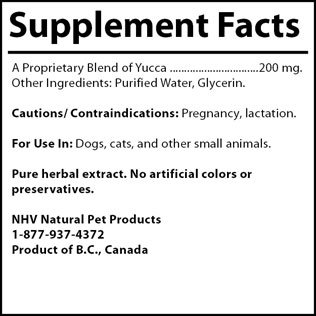
Select your pet's weight to determine the correct dose.
To be taken twice daily. Determine your pet’s weight and then use the easy chart below to determine the correct dose. This is the minimum dosage.
Pet's Weight Dosage
0 - 15 lb = 0.5 ml
16 - 30 lb = 1.0 ml
31 - 45 lb = 1.5 ml
46 - 60 lb = 2.0 ml
61 - 75 lb = 2.5 ml
Over 75 lb = 3.0 ml
How to Administer: Shake well before use. The easiest method is to use the dropper provided and place the drops into your pet’s food or favorite treat. You can also use the dropper and squirt directly into the pet’s mouth. Some pets can be finicky, if this occurs consider hiding the drops in foods most pet’s love such as fish, chicken or yogurt or a favorite treat. If your pet only eats dry food then soak a few kibbles at feeding time.
For Best Results: Herbal dietary supplements are beneficial to the health and well-being of your pet and are safe for long-term use. Every pet responds to natural herbal supplements differently, therefore it is important to be consistent and administer the product daily. Supplements generally take two to four weeks to take effect, however this will vary from one animal to the next.
Product Storage: All NHV Natural Pet Products are pure herbal extracts and contain no artificial additives, preservatives or coloring. Shelf life after opening is 6 months and must be refrigerated after opening.
Cautions and Contraindications: Do not use Yucca in pregnant or nursing animals. Speak to your vet before using our products. A second visit is recommended if your pet’s condition does not improve, or deteriorates after continued use of the supplements. All information provided by NHV Natural Pet Products is for educational purposes only.
Yucca root is widely used in dog food as well as in other pet foods. It is an herb that is highly nutritive as it is rich in vitamin C, beta-carotene, B vitamins, magnesium, iron, calcium, manganese, protein, niacin, and phosphorus. Yucca contains two very beneficial compounds: sarsasapogenin and smilagenin. These two compounds work on the mucous membranes of the small intestine. These compounds help with the penetration and absorption of minerals and vitamins. Sarsasapogenin and Smilagenin are known as steroidal saponins (phytosterols), which act as precursors to corticosteroids produced naturally by the body.
Steroidal-saponins support the immune function of the body while stimulating and supporting the production of its own corticosteroids and corticosteroid–related hormones. Due to this action, studies conducted on yucca have shown that it may be beneficial and effective for discomfort and inflammation in conditions such as arthritis. Yucca may also be effective as an appetite booster in dogs and may also help reduce the production of urease, which contributes to the unpleasant odors of urine and feces in some dogs.

Yucca for dogs is commonly used for supporting arthritis, as an anti-inflammatory, nutritive, antitumor, and digestive. Yucca for dogs is considered a nutritive herb because it is rich in vitamins and minerals like vitamin C, beta-carotene, B vitamins, magnesium, iron, calcium, manganese, protein, niacin, and phosphorus.

Select your pet's weight to determine the correct dose.
To be taken twice daily. Determine your pet’s weight and then use the easy chart below to determine the correct dose. This is the minimum dosage.
Pet's Weight Dosage
0 - 15 lb = 0.5 ml
16 - 30 lb = 1.0 ml
31 - 45 lb = 1.5 ml
46 - 60 lb = 2.0 ml
61 - 75 lb = 2.5 ml
Over 75 lb = 3.0 ml
How to Administer: Shake well before use. The easiest method is to use the dropper provided and place the drops into your pet’s food or favorite treat. You can also use the dropper and squirt directly into the pet’s mouth. Some pets can be finicky, if this occurs consider hiding the drops in foods most pet’s love such as fish, chicken or yogurt or a favorite treat. If your pet only eats dry food then soak a few kibbles at feeding time.
For Best Results: Herbal dietary supplements are beneficial to the health and well-being of your pet and are safe for long-term use. Every pet responds to natural herbal supplements differently, therefore it is important to be consistent and administer the product daily. Supplements generally take two to four weeks to take effect, however this will vary from one animal to the next.
Product Storage: All NHV Natural Pet Products are pure herbal extracts and contain no artificial additives, preservatives or coloring. Shelf life after opening is 6 months and must be refrigerated after opening.
Cautions and Contraindications: Do not use Yucca in pregnant or nursing animals. Speak to your vet before using our products. A second visit is recommended if your pet’s condition does not improve, or deteriorates after continued use of the supplements. All information provided by NHV Natural Pet Products is for educational purposes only.
Published: August 24, 2018